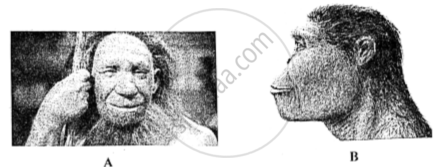Advertisements
Advertisements
प्रश्न
Try to trace the various components of human evolution (hint: brain size and function, skeletal structure, dietary preference, etc.)
उत्तर
Dryopithecus and Ramapithecus primates existed around 16 million years ago. They had a lot of hair on their bodies and walked like gorillas and chimpanzees. Among these, Dryopithecus was like apes and Ramapithecus was like humans. Fossils showing many human characteristics were found in Ethiopia and Tanzania. This makes it clear that 3-4 million years ago, human-like primates roamed in East Africa. They were about 4 feet tall and walked upright. About 2 million years ago, Australopithecines, that is, early humans, probably roamed in the grasslands of East Africa. Homo habilis is known as the first human-like creature. The fossils of Homo erectus are from about 1.5 million years ago. Java man, Peking man, Atlantic man come under this. In the last period of the Pleistocene era, Homo sapiens (real man) replaced Homo erectus. Mainly Neanderthal man, Cro-Magnon man, and present-day man come under this.
Various components of human development-
Human development took place due to the following specific components (characteristics) acquired during development -
- Bipedal locomotion - Humans walk with the help of hind legs. Forelimbs (arms) are used for other purposes. Hind limbs are long and strong.
- Erect posture - The following changes have taken place for this-
- Legs are long. Torso is small and chest is broad.
- Number of lumbar vertebrae in vertebral column is 4-5. Sacral vertebrae are integrated.
- There is lumbar curve in vertebral column.
- Pelvic girdle is basin shaped.
- Skull is straight on vertebral column. Foramen ovale is downwards.
- Face - Face of human is erect and remains straight. It is called orthognathous. In human, the brow ridges are light.
- Teeth - Being omnivorous, they are unspecialized. Their number is 32. Humans were vegetarians earlier, later they became omnivorous.
- Grasping ability - Human hands have been transformed to hold objects. Due to thumb becoming opposite, the ability to hold and lift objects developed.
- Brain & Cranial Capacity - Cerebrum and cerebellum are well developed. Cranial capacity is approximately 1450 cc. The ratio of brain weight to body weight is the highest. Due to the development of the brain, the intellectual development of humans has reached its peak. It has the incomplete ability of written speech, expression of emotions, thinking, planning and logical reasoning.
- Binocular vision - As a result of bipedalism, binocular and stereoscopic vision is found in it.
- Decrease in breeding capacity, decrease in hair on the body, decrease in olfactory sense, decrease in hearing power etc. are other evolutionary characteristics.
APPEARS IN
संबंधित प्रश्न
Organic Evolution cannot be equated with progress. Explain with the help of a suitable example.
Define ‘reproductive isolation’ and explain two types of reproductive isolation.
Given below are two stages in the evolution of man. Study them and answer the questions that follow:
Mention two characteristic features each for two stages.
Given below are two stages in the evolution of man. Study them and answer the questions that follow:
Give two examples of Vestigial organs in humans.
Answer the following questions briefly:
Mention any two objectives of ‘Swachh Bharat Abhiyan’.
The first remarkable human fossil was that of ______.
Distinguish between Australopithecus and Neanderthal man
Complete the following paragraph with the words given in brackets.
(Cro-Magnon, brain, fire, agriculture, Cultural, homo-sapiens, wise man)
Evolution of upright man continued in the direction of developing its ________ for the period of about 1 lakh years and meanwhile it discovered the __________. Brain of a 50 thousand year old man had been sufficiently evolved to the extent that it could be considered as a member of the class _______. Neanderthal man can be considered as the first example of _______. The _______ man evolved about 50 thousand years ago and afterwards, this evolution had been faster than the earlier. About 10 thousand years ago, wise-man started to practice the _______. It started to rear the cattle-herds and established the cities. _______ development took place.
Rearrange the descent in human evolution
Austrolopithecus → Homo erectus → Homo sapiens → Ramapithecus → Homo habilis.
Identify the fossil man whose remains were discovered in the Shivalik hills in India?
Identify the human ancestor which showed both ape-like and man-like characters.
Choose the CORRECT sequence of human evolution.
All are features of Homo habilis, EXCEPT ______
Where were the fossils of Ramapithecus discovered?
Features like prominent brow-ridges, low forehead, thick skull bones and outwardly curved thigh bones can be related to ____________.
Long tail, elongated tarsals, and binocular vision are seen in ______
Select the mismatched pair.
Write any eight major changes that occurred in human evolution.
Differentiate between Australopithecus and Modern man based on body hair.
Distinguish between Homo habilis and Homo sapiens sapiens (Posture).
